Introduction
Photography is one of the most promising businesses nowadays. What with the great demands for photo and video coverage of various events and occasions like weddings, birthdays, debuts, anniversaries, graduations and much more. However, with the industry booming so fast, competition is also now at its peak. Business owners or those in the photography business are now thinking of possible and probably the best way to reach a wider market in the most fashionable and quickest way.
Meanwhile, the advent of information technology has paved the way for many industries to promote their businesses in a highly technological way. E-commerce and/or e-business is now one of the most common ways of combining the power of marketing and information technology to market one’s business. It is for this reason that people in the photography business are also contemplating on whether or not to put up or market their business online.
The environment that professional photographers currently find themselves in is one where families, couples and decision makers are extremely busy and prefer to find out as much as possible about the photographers before ever stepping foot in the studio. The dimensions of marketing to these clients have changed enough that now photographers are using electronic marketing tools and websites to reach these clients. Photographers operating in today’s economic climate must have a website to effectively reach their target market.
Problem Statement
Will it be profitable? Is it practical for this kind of business to venture in such kind of marketing strategy? How can the business owners ensure the security of their business and of course of their customers? These are just some of the questions that need some answers in order to ascertain the feasibility or marketing photography using the e-commerce approach.
Methodology
In depth study and review is conducted in this paper. Most updated Websites, journals and magazines related to the subject of study are gathered and analyzed.
More so, a survey was conducted from a Professional Photographers on the Professional Photographers of America’s (PPA) Forum (www.ourppa.com/forums) and through various PPA affiliated State Associations. The research gathered then served as guides in conducting the interviews with the consumers and visual merchandisers. A total number of 256 professional photographers responded. The survey consisted of 11 questions. These respondents were chosen randomly and were asked to answer the several close-ended questions.
Results and discussion of the study is obtained by analyzing the results of the survey conducted and correlating it with the research. Mean, mode and percentage is obtained in getting the best possible results. These are then tabled and graphed for easy presentation of data.
Literature Review
The Existence of On-line Communities the will Benefit Photography
Computer mediated and hyperlink networks are very much handy today specifically to schools or big business establishments. These networks are used to link and connect computers, within a single site (local area network, or LAN) or via telecommunications systems connecting geographically dispersed sites (wide area network, or WAN). Such networks may provide users with access to shared facilities (files, software, databases, printers, fax machines), and may also provide access to communications (email and conferencing). Networks can be linked through gateways to other networks. Where this uses the common protocol and addressing system tcp/ip, an internet is created (Sturges, 1998).
The Internet has indeed become globally part of our everyday lives. From merely buying the basic necessities in life to having to get airplane flights. It has been widely useful to the students through their continuous access to faster, easier and reliable sources of different information. It has been very significant to business-oriented individuals because of its wide range of marketing and sales strategies being offered by different web owners. It has been very useful even to the simplest member of the society for you can even sell and buy things from the Internet or get credible information regarding a certain product. Yes, Internet is very much useful to everybody, and we can safely say that one is losing such big opportunity if he or she has not been accessing the Internet.
From a study conducted on July of 1995, the estimated numbers of Internet hosts for each continent are:
Table 1. Estimated Hosts Number.
Meanwhile, a recent survey done by Survey.Net has disclosed that out of 2974 total respondents (taken last May 23, 2004), majority of the people who accessed the Internet are those ages ranging from 22 – 25 years old. Meanwhile, most of the respondents (26.2%) were presently enrolled in college (as to their highest degree attained).
Meanwhile, Adamic et al. has searched and sourced out different studies prior to theirs, focusing on characterizing online interaction and measuring the effect of Internet on real life social interactions. They were able to find out that even through the most basic and simplest community website, people were able to chat, organize events, share opinions on different issues presented, share and view photographs, make announcements and even meet new friends (Adamic, et.al., 2003).
E-groups, E-messaging, MIRcs, and different personal blog sites (like Multiply, MySpace, Friendster and even Bebo) are just few of the famous community websites that has been established and being patronized by many. A lot of cyber relationships started with this community websites. Even job opportunities, job applications and/or job hunting are now presented in numerous community websites. Schools and various other institutions are giving assignments and research works using community websites in the pursuit of allowing the learners to familiarize themselves with these websites. This process eliminates tedious processes on information gathering specially on survey types, because small and expensive mails, phone calls and likes were avoided (Adamic, et.al., 2003).
As stated above, Internet and On-line communities have reached even the youngest of the young, or the farthest place all over the world. With this idea, marketers and business minded individuals were able to see the big business opportunities offered by the networks – hence, commercial markets for networks was born. Companies like the Cisco Systems, Proteon, and Wellfleet (now Bay Networks) and 3Com are some of the best examples of the companies who opted to manufacture and sell “routers” (the commercial equivalents of the “gateways” (Cerf, 1997). These companies can serve as good examples and basis as to how much benefit can photography gain if it also make its presence felt in the world wide web.
Photography and the E-commerce Approach
Photography has been a long-standing business. It has been part of every one’s life. From the mere and simple personal events to more extravagant activities such as in the movie industry, photography is said to be always present. And amidst all of this seemingly continued productivity of photography as a business, it is still a big consideration for the photographers of the business owners to combine information technology in their marketing and/or promotional strategies.
E-Commerce and How will it Benefit the Photographers
E – commerce simply means electronic business. It is making business through electronic media more known as the Internet. E – Commerce is the means of selling goods on the Internet, using web pages. This involves much the same processes as selling goods elsewhere, but in a digital format. Presentation, placement, display, stocking, selling and payment are all familiar concepts involved on the e-commerce process. Goods are presented as images with text descriptions, prices and product options. Instead of “printing” each product web page uniquely, only one page is made, and filled in by a database.
Electronic commerce is a means of enabling and supporting bigger changes on the business world at a global scale. It enables companies to be more efficient and flexible in their internal operations, to work more closely with their suppliers, and to be more responsive to the needs and expectations of their customers. It allows companies to select the best suppliers regardless of their geographical location and to sell to a global market.
One special case of electronic commerce is electronic trading, in which a supplier provides goods or services to a customer in return for payment. A special case of electronic trading is electronic retailing, where the customer is an ordinary consumer rather than another company. However, while these special cases are of considerable economic importance, they are just particular examples of the more general case of any form of business operation or transaction conducted via electronic media. Other equally valid examples include internal transactions within a single company or provision of information to an external organization without charge.
Benefits and Social Impact of Photography in the E-business
Despite the early technological limitations of the Internet, companies were still quick to recognize the value of the Internet and the World Wide Web in particular as a medium to reach out to customers all over the world (Hoque, 2000).
The impact of electronic business will be pervasive, both on companies and on society as a whole. For those companies that fully exploit its potential, electronic commerce offers the possibility of breakpoint changes – changes that so radically alter customer expectations that they re-define the market or create entirely new markets. All other companies, including those that try to ignore the new technologies, will then be impacted by these changes in markets and customer expectations. Equally, individual members of society will be presented with entirely new ways of purchasing goods, accessing information and services, and interacting with branches of government. Choice will be greatly extended, and restrictions of geography and time eliminated. The overall impact on lifestyle could well be comparable to, say, that of the growth in car ownership or the spread of the telephone (Definition of E-business, 1997).
The boundaries of electronic commerce are not defined by geography or national borders, but rather by the coverage of computer networks. Since the most important networks are global in scope, electronic business enables even the smallest suppliers to achieve a global presence and to conduct business world-wide (Definition of E-business, 1997).
Electronic business enables suppliers to improve competitiveness by becoming “closer to the customer”. As a simple example, many companies are employing electronic commerce technology to offer improved levels of pre-and post-sales support, with increased levels of product information, guidance on product use, and rapid response to customer enquiries. The corresponding customer benefit is improved quality of service (Definition of E-business, 1997).
With electronic interaction, customers are able to gather detailed information on the needs of each individual customer and automatically tailor products and services to those individual needs. This result in customized products comparable to those offered by specialized suppliers but at mass market prices. One simple example is an on-line magazine that is tailored for the individual reader on each access to emphasize articles likely to be of interest and exclude articles that have already been read (Definition of E-business, 1997).
Electronic business often allows traditional supply chains to be shortened dramatically. There are many established examples where goods are shipped directly from the manufacturer to the end consumer, by-passing the traditional staging posts of wholesaler’s warehouse, retailer’s warehouse and retail outlet (Definition of E-business, 1997).
One of the major contributions of electronic business is a reduction in transaction costs. While the cost of a business transaction that entails human interaction might be measured in dollars, the cost of conducting a similar transaction electronically might be a few cents or less. Hence, any business process involving “routine” interactions between people offers the potential for substantial cost savings, which can in turn be translated into substantial price reductions for customers (Definition of E-business, 1997).
In addition to re-defining the markets for existing products and services, electronic business also provides the opportunity for entirely new products and services. Examples include network supply and support services, directory services, contact services (i.e. establishing initial contact between potential customers and potential suppliers), and many kinds of on-line information services (Definition of E-business, 1997).
Survey Results and Discussion
Below are the results (graphical representation and/or in a numerical form) from the internet marketing survey conducted.
Do you currently have a website?
Yes – 256 (100%)
This only shows that all of the 356 respondents now run their own websites which they use not only for personal functions but also to highlight their products and services.
How effective do you consider your website to be in attracting new clients?
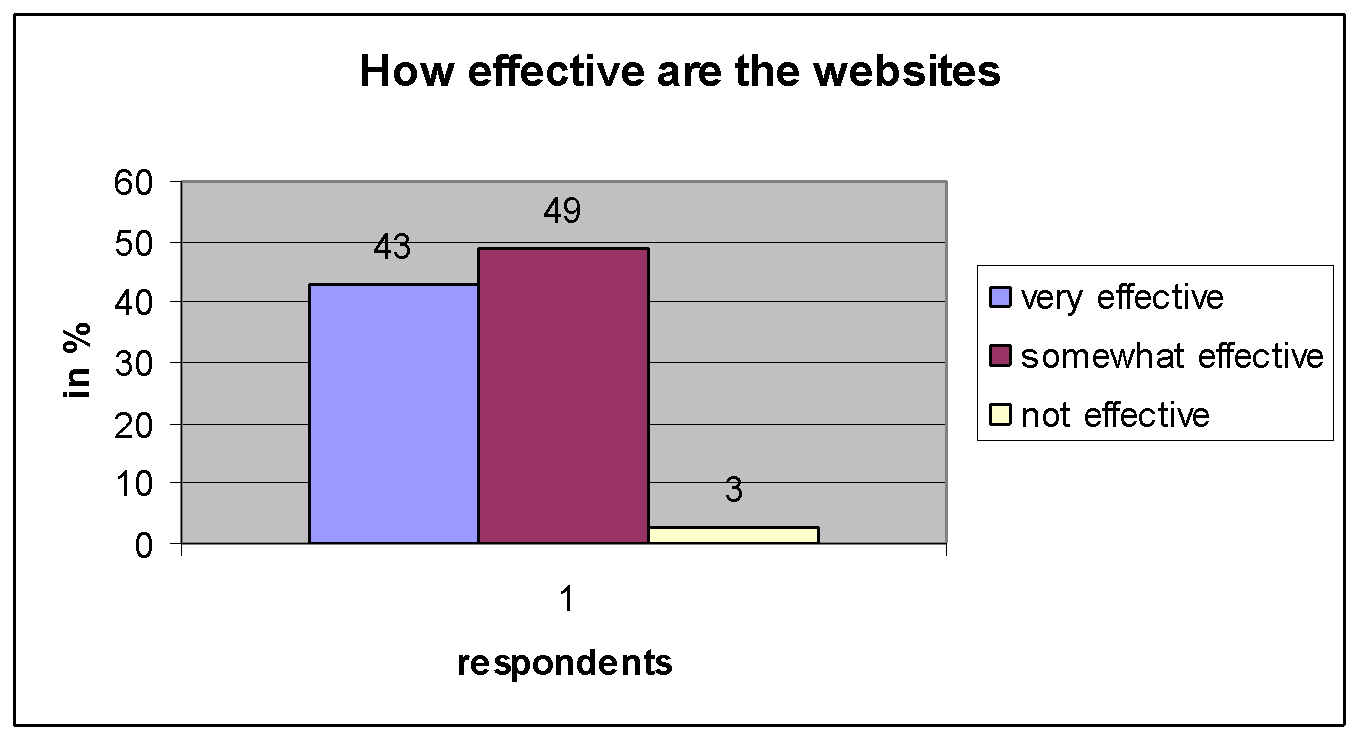
Approximately how many visitors do you have to your website each month?
Based on the survey results, an average of 300 visitors log in on the photographers’ website every month. Considering that there are hundreds of photographers and websites that can be accessed in the Internet, this number is worth noting.
Do you currently advertise with any publication that uses the internet for marketing your services?
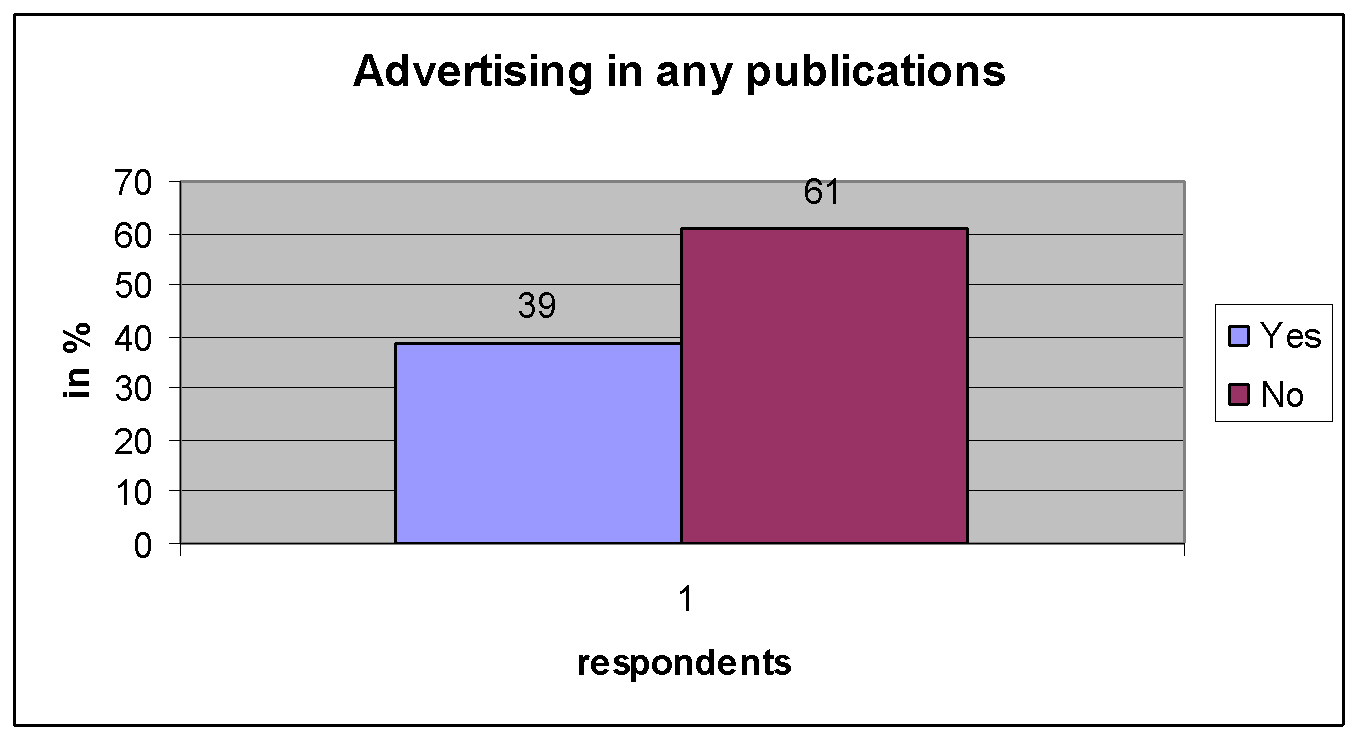
What is your main style/type of photography?
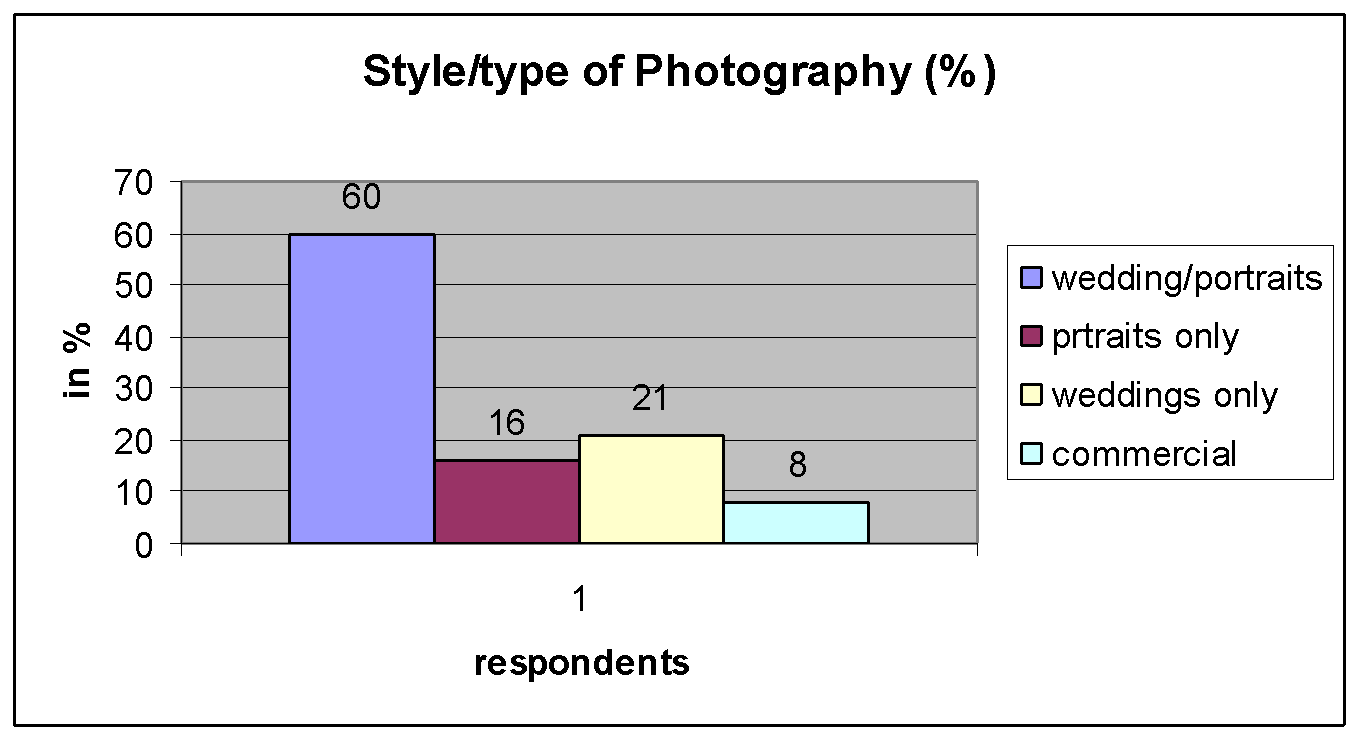
The graph above shows that photography is used in many different ways as a form of business, and the top most of it all is in wedding and portraits. This is where the biggest market lies for the photographers. This graph can also demonstrate that there is a big potential for photography to grow even bigger when marketed in the websites.
Do you currently show client images from their sessions on the internet?

Do you currently sell your clients their images on the internet?
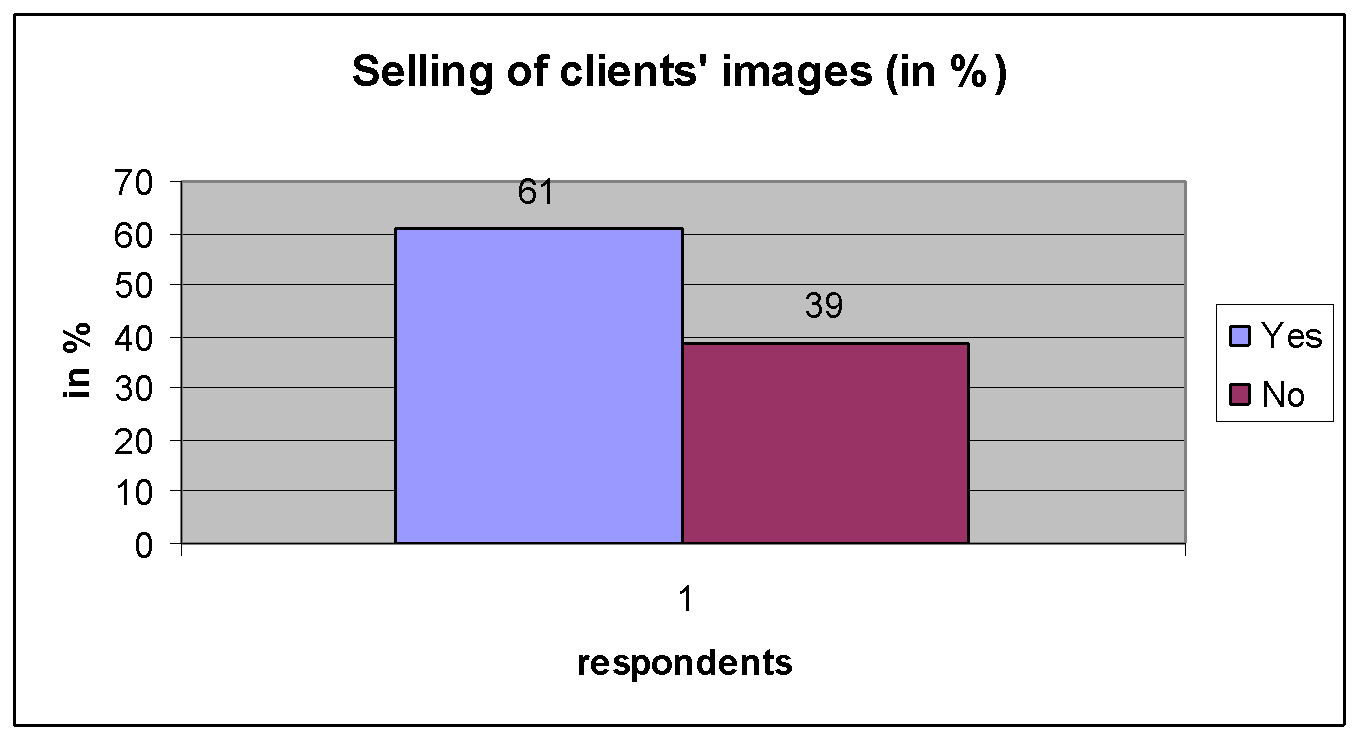
Below are the results to questions concerning the respondents (156) who show and sell images to clients on the internet.
If you answered yes to both Questions 6 and 7, have you seen your sales increase, decrease or stay the same?
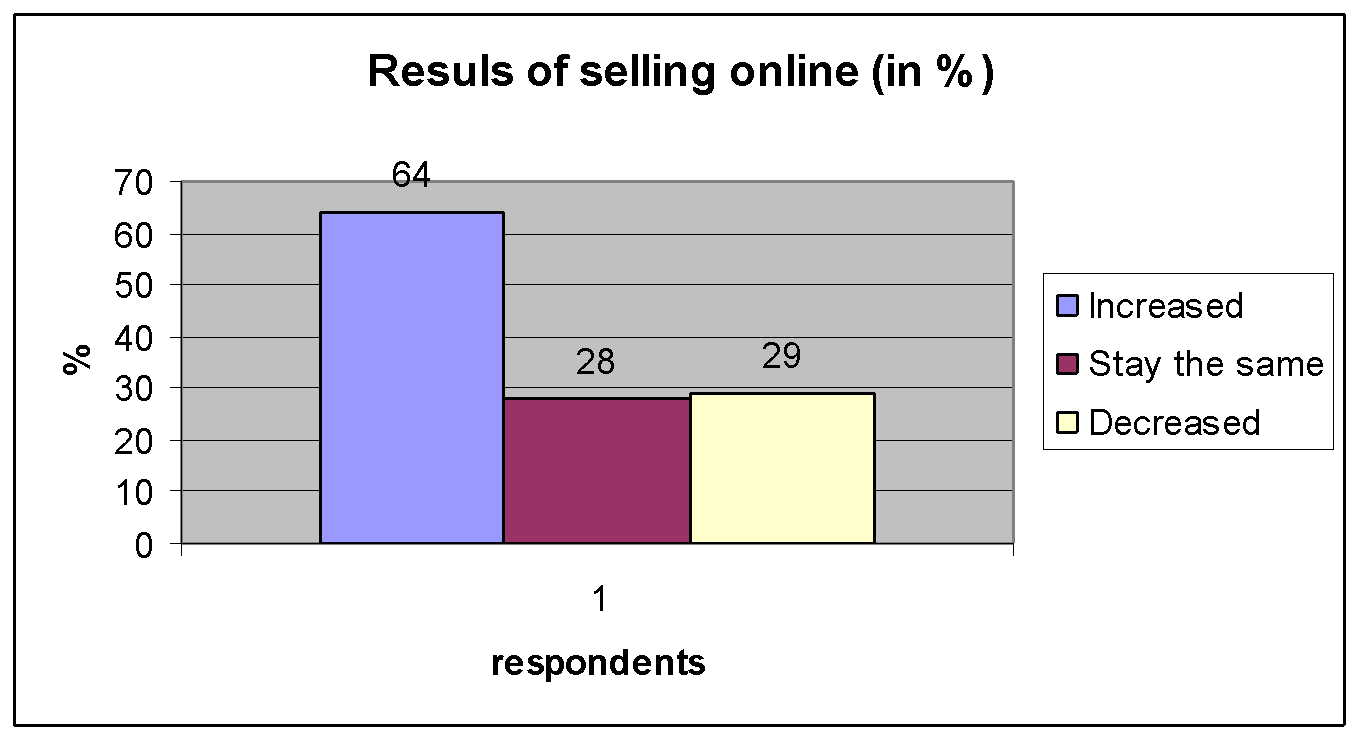
This graph shows that a big percentage or majority of those who show and sell their clients’ images online became more productive and has increased sales. This very graph alone represents how profitable internet or online selling and marketing can be for the photographers.
What was your main reason for getting a website?
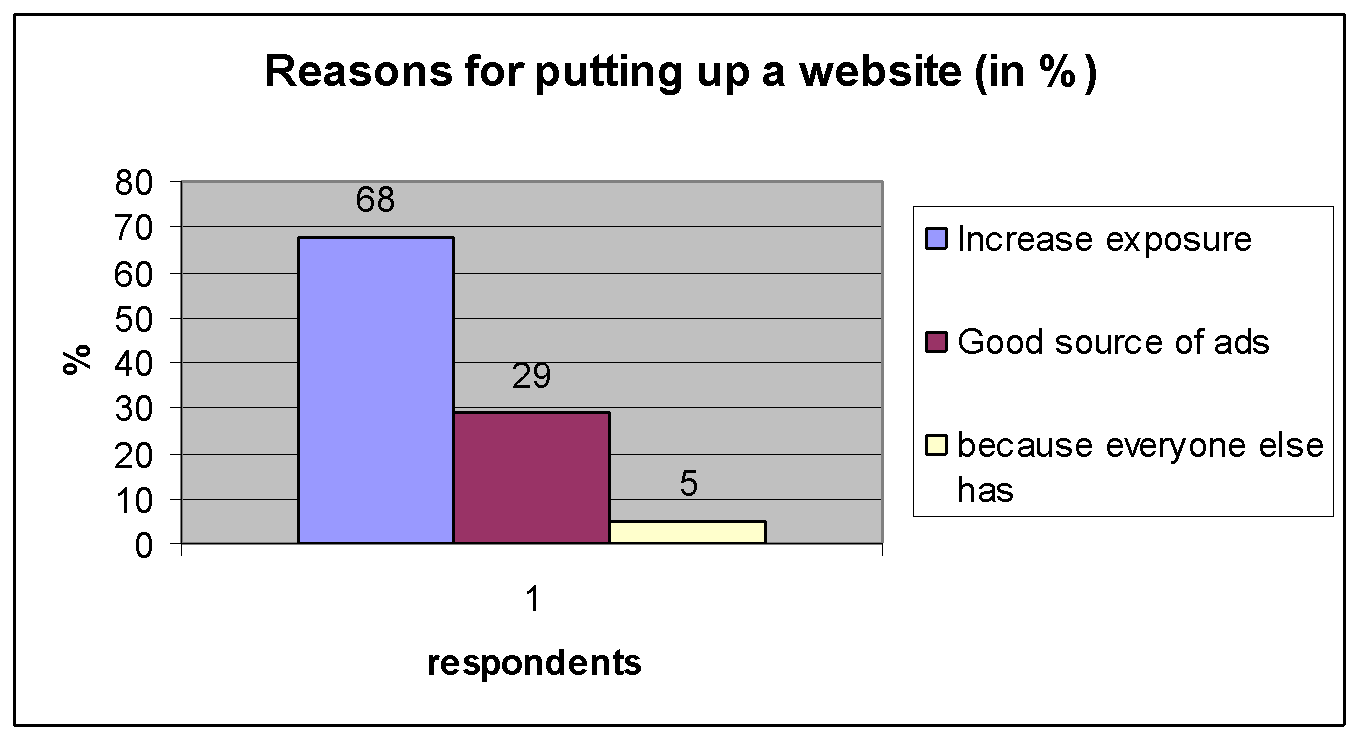
Did you design and create your own website?
Majority (64%) or 164 of the overall respondents have created and designed their own websites while only 36 % (or 39 from the total number of respondents) created their own. This shows that still the majority of those who have their websites wanted to highlight their own creativity by designing and or personalizing their own websites. This will help them impart to their target customers how their creative thinking works.
Would you consider not having a website again?

With the response gathered above, it shows that a big part (95%) of the total respondents would want to continue using their websites to market their photography. They have seen how it works and they have proven for themselves that their products and services become more marketable when promoted online.
Conclusion
Because of such advantages in the e-commerce or internet approach, it is of no doubt that marketing photography through online will be profitable. Some famous photographers and website users even commented that:
“In this era of digital imaging and information technology, some sort of presence on the web is absolutely mandatory for every photographer. Whether it’s just a simple portfolio page with contact information, or a full-blown storefront, you not only have to use the web, but not using it can hurt your business.” (Heller, Dan)
“With the click of a mouse, you can find nearly anything on the web these days, from a public company’s earnings, to a private company’s business descriptions to pricing schedules and office locations” (Kaplan, Steve)
“If you do not have a website, get one started by the end of the week-a website is essential…” (Williams, Robert)
Thus, it is of no doubt that photographers in the 21st century should adopt the advent of the world wide web and make their presence felt through online. They can maximize profits and productivity if they have their own websites where their can reach a wider market.
Reference list
A Profile of the Internet. 2004. Web.
Adamic, Lada, et. Al. A Social Network Caught in the Web. 2003. Web.
Cerf, Vinton G. Computer Networking: Global Infrastructure for the 21st Century. 1997. Web.
Hoque, Faisal. E-Enterprise _ Business Models, Architectures and Components. Cambridge University Press. 2000.
May, Paul. The Business of E-Commerce. Cambridge University Press. 2000.
Definition of E-Commerce. 1997. Internet Business, Interest Verlag, Germany Augsburg. Web.
E – Commerce Definition. 2003. Web.
E-Commerce and Internet Business Statistics. 2001. Plunket research Inc. Web.
Heller, Dan. Web.
Kaplan, Steve Be the Elephant. page 34.
Sturges, Paul. Freedom of Expression and the Communication Networks. 1998. Web.
Survey: Intellectual Property Rights. 2003. Survey. Web.
Williams, Robert. Rangefinder Magazine. Page 41. 2007.